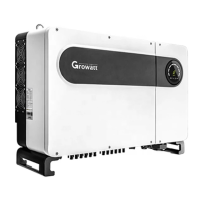
Do you have a question about the Growatt MAX Series and is the answer not in the manual?
| Max. DC Voltage | 1100 V |
|---|---|
| MPPT Voltage Range | 200-1000 V |
| Number of DC Inputs per MPPT | 2 |
| Nominal Grid Frequency | 50/60 Hz |
| THDi | <3% |
| DC Switch | Yes |
| MPPT | Yes |
| Communication | WiFi, GPRS, Ethernet |
| Nominal AC Voltage | 400 V |
| AC Voltage Range | 310-480 V |
| Power Factor | 0.8 leading ... 0.8 lagging |
| Operating Temperature Range | -25°C to +60°C |
Provides information and instructions for installing MAX series solar inverters.
Details requirements for qualified electrical technicians for installation and troubleshooting.
General safety guidelines, handling precautions, and warnings for installation.
Specific safety warnings and procedures related to inverter installation.
Explains the meaning of danger, warning, caution, and notice symbols used in the manual.
Describes various labels and symbols found on the inverter, including their meanings.
Details the inverter's physical appearance, dimensions, weight, and key specifications.
Illustrates the inverter's nameplate with key technical specifications and certifications.
Explains the inverter's operation and guidelines for proper storage.
Covers grid connection types and optional AFCI/Anti-PID functions.
Instructions for checking package contents for damage and missing items.
Key requirements for installing the inverter, including wall strength, space, and environmental conditions.
Specifies environmental conditions to avoid for optimal inverter performance and lifespan.
Safety guidelines for moving the heavy inverter to prevent injury and damage.
Step-by-step guide for installing the wall mount bracket for inverter mounting.
Instructions on how to safely lift and mount the inverter onto the installed wall bracket.
Procedures and safety warnings for connecting the AC power cables to the inverter.
Cable specifications and step-by-step instructions for connecting AC output cables.
Safety precautions and procedures for connecting the DC input cables from PV panels.
Guides for connecting RS485, USB, and GPRS/4G communication cables.
Instructions for installing monitoring modules via USB.
Instructions for connecting the antenna for GPRS monitoring.
Procedures for properly grounding the inverter and system components for safety.
Initial setup, address, time, and date configuration for the inverter.
How to set the communication address for the inverter using Shinebus or ShinePhone APP.
Methods for setting the inverter's internal clock and date via APP or GPRS.
Explains inverter operation modes, states, and LED status indicators.
Explains the meaning of different LED indicators on the inverter for status monitoring.
Methods for remote monitoring via ShinePhone app, GPRS/4G, and ShineMaster.
Guide to downloading, registering, and using the ShinePhone mobile app.
Details the functions and information available on the device management page within the app.
Information on adding and managing dataloggers for system monitoring.
Steps for registering an account and adding dataloggers for GPRS/4G monitoring.
How to view production, revenue, and power flow charts on the plant data page.
How to view device power, voltage, and other data charts on the plant data page.
Guidance on setting up devices via the device management page in the Growatt system.
Instructions on how to view detailed device data by double-clicking in the device list.
Introduction to the ShineMaster device and its setup for solar plant monitoring.
Steps to find the ShineMaster's IP address to access its interface.
How to access the ShineMaster's built-in configuration page via a web browser.
Procedures for adding or deleting photovoltaic devices from the ShineMaster system.
Detailed steps for adding a new device to the ShineMaster monitoring system.
Steps to delete a photovoltaic device from the ShineMaster monitoring system.
Instructions for registering and logging into ShineServer to upload and view monitoring data.
How to view monitoring data, including power flow charts, on the ShineServer interface.
Modes for local inverter data monitoring via mobile app or PC.
Guide for local monitoring using the ShinePhone app, including login and debugging.
First method to log into the ShinePhone app for local monitoring.
Second method to log into the ShinePhone app for local monitoring.
Details on using local monitoring and debugging features within the ShinePhone app.
Configuring inverter parameters and performing intelligent diagnostics via the app.
Viewing detailed device data and status through intelligent detection.
Remotely scanning MPPT I-V curves for diagnostics.
Detailed fault detection, real-time data, diagnostics, and device info access.
Observing inverter voltage and current quality in real-time.
Performing comprehensive diagnostics like I-V curve and THDV analysis.
Accessing detailed device information including voltage, current, and parameters.
Using a U disk for firmware, fault recording, and curve analysis.
Steps to program the inverter using firmware files on a U disk.
Process for creating a file to record fault information onto a U disk.
Using a U disk to record and analyze I-V curves.
Procedures for routine maintenance, including inverter and fan cleaning.
Steps for cleaning the inverter, including safety precautions.
Procedures and safety guidelines for cleaning or replacing inverter fans.
Guides for troubleshooting, understanding warnings, and interpreting error codes.
Explanation of warning codes and their meanings for inverter status.
Lists and explains various error codes that may appear on the inverter.
Detailed DC input parameters for MAX series inverters.
Detailed AC output parameters for MAX series inverters.
Efficiency ratings for different inverter models.
Lists the various protection mechanisms implemented in the inverter.
Lists certifications and approvals obtained by the inverter models.
Specifies the operational temperature limits for the inverter.
Indicates the Ingress Protection (IP) rating of the inverter.
Procedures for safely decommissioning the inverter.
Instructions for safely disposing of the inverter as e-waste.
Please refer to related file.
Information required when contacting Growatt for technical support.
